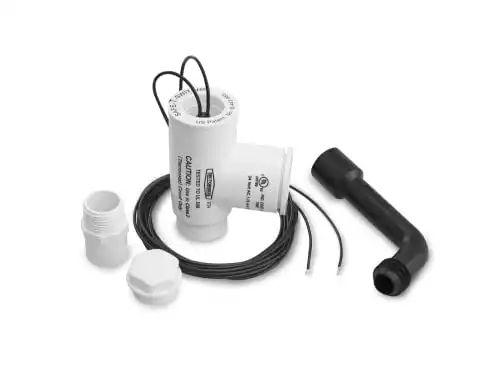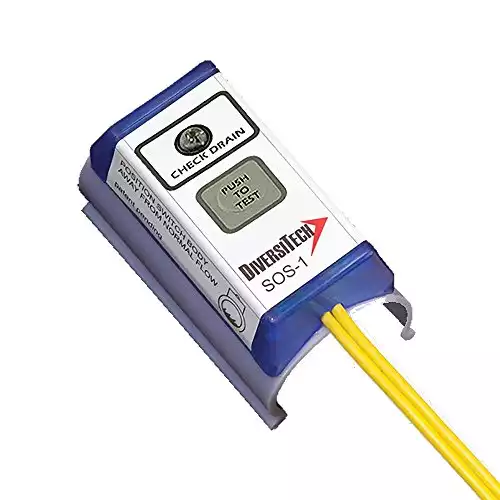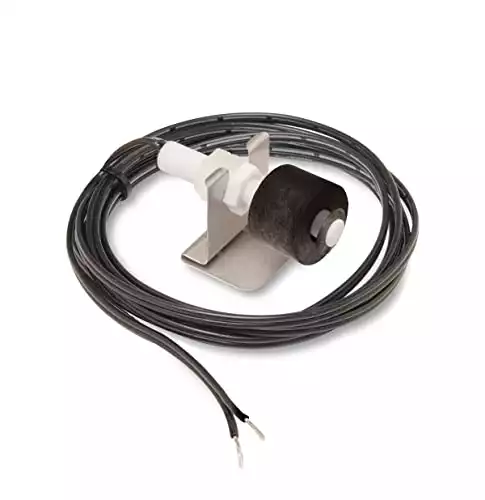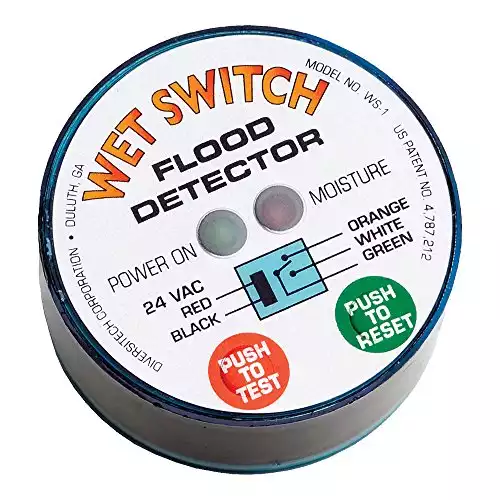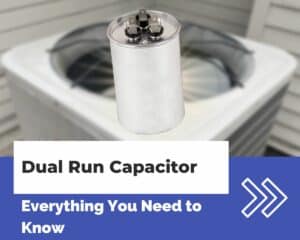HVAC Training Shop is reader-supported. As an Amazon Associate, I earn from qualifying purchases.
Did your AC stop working on a hot, muggy day?
When your AC’s condensate drain gets clogged, water can come gushing out of your AC system.
That’s why most central AC systems have one or more float switches installed—to prevent an overflow of water and damage to your home.
But what do you do when your AC float switch trips? And how does an AC float switch work, anyway?
In this article, I’ll go over what you need to do when your AC’s float switch trips.
I’ll also go over how an AC float switch works, and all the different types of float switches. That way you’ll be prepared for any float switch issues you come across.
What to do when your AC float switch trips
If your AC float switch trips, you need to remove the blockage in your condensate drain system. An AC float switch trips when water builds up in your AC system, so you need to get your condensate drainage system unclogged in order for your float switch to reset.
Check out my article below for more information about clogged AC condensate drains:
After your condensate drain line or drain pan is clear of water and clogs, your float switch should reset automatically.
Some float switches have a manual reset, I’ll talk about those below.
How to reset an AC float switch
If your float switch trips and turns off your AC, you need to clear the condensate blockage, and your float switch should reset automatically.
But what if your float switch has a manual reset—such as a lever or button?
After you clear your drain line or drain pan, you can then move on to manually resetting the float switch.
There are a few different ways to reset an AC float switch with a manual reset—depending on what kind of float switch it is:
- Float switches in condensate drain lines usually have a lever on them. Press the lever on the side of the float switch to reset the float switch.
- Wet switches and electronic float switches usually have a “reset” button. Press the reset button on the float switch or wet switch. Keep in mind that the membrane on the bottom of a wet switch needs to be completely dry before resetting it.
- If an electronic float switch doesn’t have a reset button, cycle the power to your AC’s air handling unit to reset the switch.
How does an AC float switch work?
An AC float switch works by detecting the presence of water with a mechanical floatation device. When the water level reaches a threshold, the float moves upwards and disconnects a wire to prevent your AC from running.

So why are float switches installed anyway?
A float switch is installed on your AC system to prevent water leakage from your AC system.
Under normal operating conditions, the drain pipe removes water from your AC system. But if that pipe gets clogged, water starts building up and may leak out of your unit.
An unchecked water leak has the potential to cause major damage to your home—that’s where the float switch comes in.
The float switch detects when the water reaches a certain level in your AC’s drain pipe or drain pan. Once the water reaches a certain threshold, the switch trips and turns off your AC.
Once the float switch is tripped, your AC won’t run. So you’ll need to address the situation by removing the clog and draining the water before your AC will run again.
Where is the AC float switch located?
AC float switches are located in the following places:
- Condensate drain line
- Condensate drip pan
In any AC installation, it doesn’t hurt to add more float switches. For example, an installer might opt to install a float switch in one or more of the following locations:
- Primary drain line
- Secondary drain port
- Condensate drip pan
- Auxiliary/secondary drip pan
For each of these installations, one type of condensate switch might work better than another.
Here are the types of condensate switches that you’ll find installed on AC units:
Float switch in condensate drain line
Drain line condensate switches are housed in a PVC pipe to allow for installation in a drain line or drain outlet.
They are installed on either a stub or in line with a condensate drain line. You can also install these types of switches on the outlet of a condensate drain pan or the secondary drain outlet on your AC’s air handler.
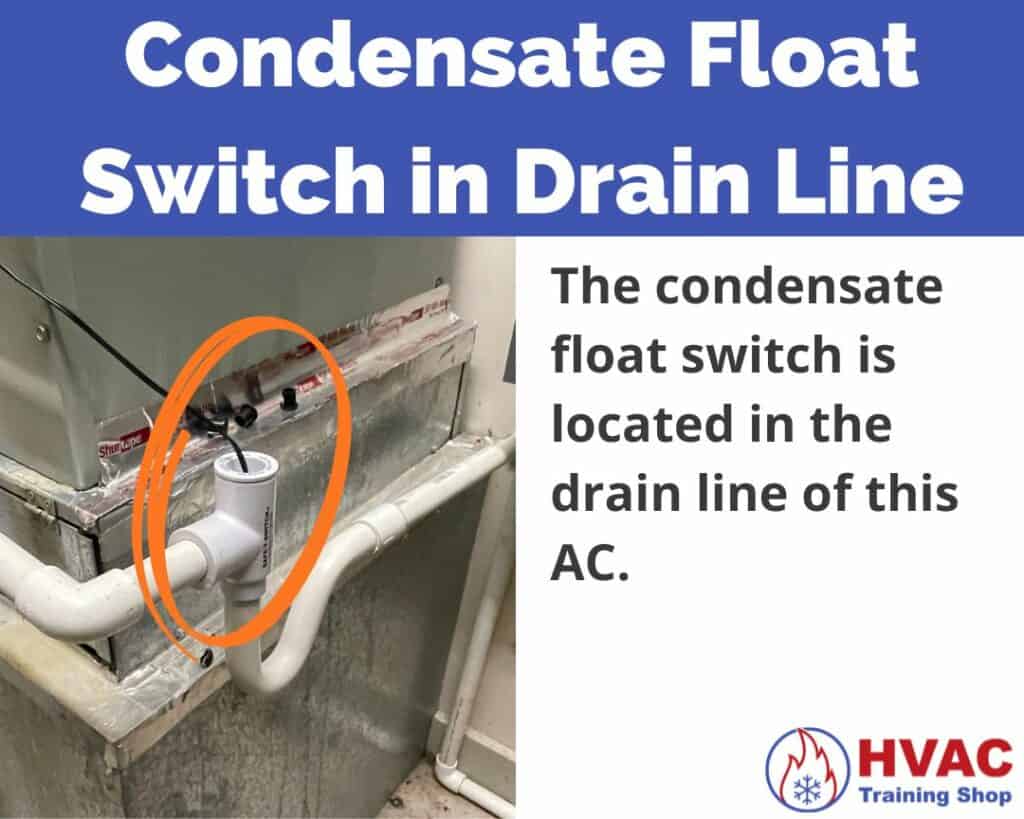
This type of float switch is popular because almost every central AC has a condensate drain line. So this type of switch can be installed on pretty much any central AC.
The drawback of a drain line condensate switch is that you need to do some plumbing to install it. It’s not too difficult but can deter some people if they’re not comfortable doing plumbing work.
For that reason, you’ll mostly see this type of float switch installed at the same time as the AC, when the installer is doing all of the plumbing work.
The SS1 float switch is a versatile float switch—it can be installed inline with any drain line or directly on a drain port. However, you'll need to do a bit of plumbing work to install it.
Electronic float switch on condensate drain line
There is also a type of electronic float switch that attaches to the outside of the condensate drain line. This type of switch uses an electrical signal to detect the water level inside the drain pipe.
When the water in the drain pipe fills up, a change in capacitance occurs. The sensor detects the change in capacitance and turns off your AC.
You can adjust the sensitivity of an electronic float switch by adjusting its position around the perimeter of the pipe.
For example, an electronic float switch on the side of the condensate drain pipe will trip when the pipe is half full.
The SOS-1 is an electronic float switch that detects the presence of water in a drain pipe. It uses a non-invasive method of installation—just snap it on your drain pipe and wire it in.
Float switch in condensate drain pan
A drain pan condensate switch clips onto the side of the drain pan.
This is one of the simplest types of float switches. This type of float switch uses a mechanical float to break an electrical connection when water reaches a certain level in your drain pan.
This type of switch sometimes has an adjustable float, so you can set the level at which the switch will trip.
The condensate drain pan float switch is also easy to install. Simply clip it on the side of your drain pan. Some models require you to set a screw or adjust the float but that’s it.
The SS3 float switch is a simple device, designed to install directly in a drain pan. This float switch is adjustable, so you can modify the water level at which the switch will trip.
Wet switch in condensate drain pan
There is also the wet switch. A wet switch is an electronic switch that detects the presence of water.
Wet switches have no moving parts. Instead, the wet switch measures the capacitance through a water-permeable membrane. If the membrane gets wet, the wet switch senses the capacitance increase.
So if any water comes into contact with the wet switch, the switch will trip and turn off your AC unit.
Wet switches are normally used in drain pans. They are there to detect the presence of any water that leaks out from the AC’s air handler.
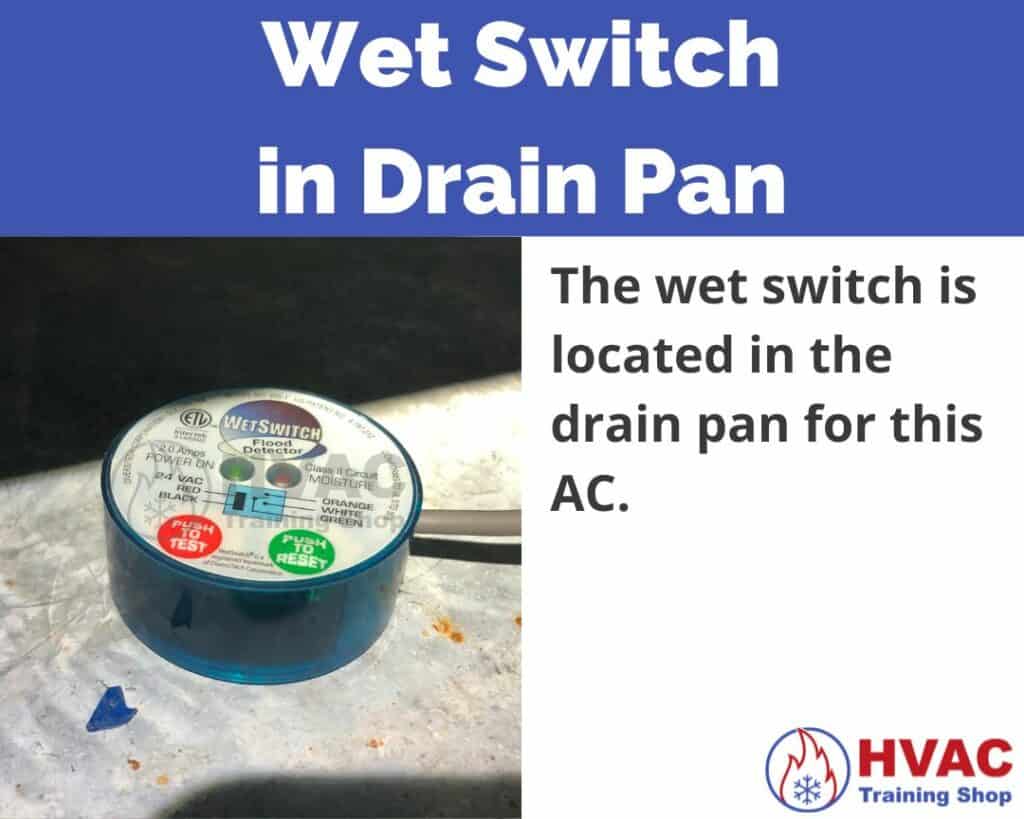
The wet switch is sometimes called a “hockey puck” switch because of its appearance.
The wet switch is also one of the easiest switches to install since you don’t need to do any screwing, plumbing, or attaching. Just put the wet switch in your drain pan and you’re good to go.
However, some wet switch models have additional wiring that’s involved—which can deter some people if they’re not comfortable with wiring.
The WS-1 wet switch is perfect for use in drain pans. It can even be used directly on the floor—that way you can ensure that your AC shuts down if it starts leaking water.
How to test an AC float switch
The best way to test an AC float switch is to plug the drain downstream of the float switch and run your AC until the float switch trips. This ensures that your float switch will perform in actual running conditions.
However, it may take a while for your float switch to trip if you plug your drain and run your AC unit. That’s why most people opt to pour water into their condensate drain pipe or pan to speed up the process.
The main drawback of pouring water into your AC drain to test your float switch is that you could miss a small leak in your drain system.
Another way to test an AC float switch is to use its “test” mode.
Some float switches have a test mode on them. The test mode is usually a button or a lever on the float switch.
You’ll usually find test buttons on wet switches. Some models of drain line float switches have test levers that you can flip up to test the float switch.
What’s the difference between an AC wet switch and a float switch?
The main difference between a wet switch and a float switch is that a wet switch trips when it detects the presence of ANY water, while a float switch trips when the water level reaches a certain point.
Wet switches and float switches are also used in different applications:
- Float switches are used in drain pipes and drain pans. A float switch trips when water reaches a certain level.
- Wet switches are used in drain pans or placed directly on the floor. A wet switch trips when it comes into contact with water.
How to bypass an AC float switch
If you ever find yourself in a situation where your float switch is stuck open and you need to get cooling to your home quickly, you can bypass your AC’s float switch.
However, exercise caution when bypassing an AC float switch since you’ll expose your home to potential water damage if your AC overflows or the drain gets backed up.
To bypass an AC float switch, follow these steps:
- Turn off the power to your AC. An AC float switch has electrical connections that can shock you while the switch is energized.
- Disconnect the two wires from your AC float switch’s wires. If you have an AC float switch with more than two wires, you’ll need to remove the wires from the common and normally closed (NC) wires on the float switch.
- Find the two wires that you disconnected from the AC float switch, and connect them to each other instead. By doing this you have bypassed the AC float switch.
- Turn the power to your AC back on.
Keep in mind that by bypassing your AC float switch, you’re removing a safety device from your AC system.
While a condensate overflow won’t cause you much physical harm, it has the potential to cause major damage to your home.
So exercise caution and keep a close eye on your AC if you bypass the float switch. And remember to get a replacement float switch installed quickly!

